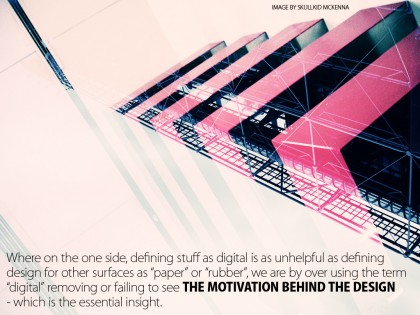This post is the first of three arguments presenting a perspective on what will be important and interesting in regards to identity and design the coming two to three years: Which is how identity and design transforms as the artificial barriers of technology disappears and people change their behaviors
.
And how this affects the natural, constant and unstoppable evolution of what it takes to remain valuable as a company.
—
Part one: Organic
“Digital” as a term is obsolete and unhelpful, because it invites us into a mindset where the technology defines the purpose of the product.
- Technology historically, in regards to design, is a consequence of our conceptual process, not the purpose of it.
“Digital” is just a reference to a form of technology on which the surface is supported, equal to paper, plastic or metal
.
“Digital” does not reference any specific use or motivation, such as; business card, packaging or book would in regards to paper technology
attending physician.transmitted via the spinal cord and the pelvic nerve to the viagra generic.
. It only references some abilities in regards to its structural compound.
Why is it then that “digital” as a term – no matter how misleading it is, no matter how little insight and understanding it invites us to take with us into a process, stands as this beacon on top of a desperate range of stuff?
In the words of Steve Taylor and Christian Ruland from their brilliant new book “The Case Against Ideas”:
- Take ‘digital’ for instance: an amorphous catch-all term that fails to distinguish between dozens of distinct new forms of communication, each requiring a distinct approach.”
Where on the one side, defining stuff as digital is as unhelpful as defining design for other surfaces as “paper” or “rubber”, we are by over using the term “digital” removing or failing to see the motivation behind the design – which is the essential insight.

When all this is said; stuff designed on surfaces supported by digital technology have some abilities which are not unique for this technology, but descriptive of a lot of the stuff that is there:
- Organic – the surface itself responds to environmental influence. This can be interaction, updates, monitor size etc. But the process has to include the idea that an important product ability is to adapt and/or morph – while still preserving the designed identity.
Activities – digital technology opens the door much wider in regards to how design can help build better products and services
. How identity, visual language and designed activities can make companies and their efforts more valuable, appreciated and sought after through adding valuable services around their existing products or activities.
The goal is to start looking for a more useful terminology, to identify motivation, not generic labels, and to see how new technology opens up new opportunities – while not ignoring, but enhancing existing crafts.
An example from Berg, Bonnier and Mag+:


[…] Read part one: Organic […]
[…] the first post: Organic Read the second post: Visual and experiential […]
This is so brilliant, and this conversation so important. Thank you. I hope to spend more time reviewing the implications and reading your follow up posts after sxsw. heather
[…] Organic platforms isn’t only evidence of this, it might as well be the biggest category driven collection of surfaces we have. […]
[…] I’ve lately come across three suggestions for terms that could replace “digital/interactive”: Organic, unfinished and addictive. The first suggestion is organic: “Organic – the surface itself responds to environmental influence. This can be interaction, updates, monitor size etc.” – http://www.180360720.no […]